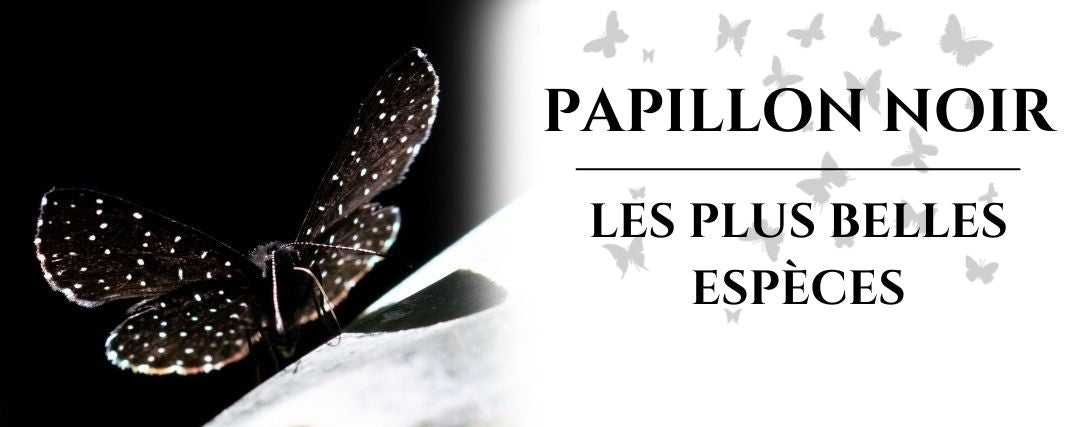The secret to the black color of butterflies isn't an excess of melanin, the pigment responsible for the black color of crows. Instead, it comes from the unique structure of their wings. This structure reflects light until it dissipates. The less light reflected, the darker the wings appear.
Are black butterflies rare?
Most butterflies have black patterns on their wings. Those with predominantly black wings, like the ones we'll discuss here, are rarer but still relatively common. Orange-black and yellow-black are two common color combinations among Lepidoptera.
Where can they be found?
Black butterflies are abundant worldwide except in Antarctica, although some species have limited habitats.
What do black butterflies symbolize?
Black butterflies are less common than butterflies of other colors. Depending on the culture, a black butterfly can symbolize negative or positive meanings. According to some beliefs, seeing the first black butterfly of the season indicates approaching storms or increased precipitation.
A black butterfly is often seen as a symbol of misfortune and an omen of death in many cultures, while in others it signifies positive change.
The "death" symbolized by the black butterfly can also represent the end of something like a relationship, job, or idea. In many cultures, the black butterfly is a symbol of transition, renewal, or rebirth, signifying that darkness often precedes dawn.
Some cultures associate black butterflies with witches. An old legend says that a black butterfly flying around the house is a witch transformed to steal food. In Aztec mythology, the warrior goddess Itzpapalotl, known as the "obsidian butterfly," is associated with the black butterfly. An ancient Aztec myth describes Itzpapalotl disguising herself as a black butterfly to devour souls during a solar eclipse.
The most beautiful black butterfly species around the world
Papilio polyxenes

Papilio polyxenes, also known as the Celery butterfly, belongs to the Papilionidae family and can reach a wingspan of 11.5 cm.
The upper side of their wings is black with two rows of yellow spots at the tips. In females, these yellow spots are narrower and lighter, or absent as in North America. On the upper side of the hindwing, males have iridescent blue spots, while females have an iridescent blue band. There is a large red spot with a black center near the tail. Under the forewing, there are yellow spots, and the underside of the hindwing has a row of red-orange spots with blue caps followed by red spots with black centers near the tail.
Papilio polyxenes are found from southern Canada to South America, most commonly east of the Rocky Mountains in North America. They thrive in open areas like fields, parks, swamps, or deserts, preferring tropical or temperate climates.
Heliconius charithonia
![]()
Heliconius charithonia is a medium-sized butterfly from the Nymphalidae family.
The wings are black to brown with narrow white and yellow stripes, similar on the ventral side but paler with red spots. Wing spans range from 70 to 100 mm. The black and white stripes are aposematic, deterring predators.
This species is found throughout South and Central America and as far north as Texas and Florida, with northward migrations during warmer months. They frequent canopies, humid forests, edges, or fields.
Heliconius charithonia forms groups of up to 60 members at night to protect against predators. They feed on pollen and nectar; pollen helps them synthesize cyanogenic glycosides, making them toxic to predators.
Papilio troilus

Papilio troilus is a black butterfly from the Papilionidae family.
Its wingspan ranges from 76 to 102 mm. The wings are primarily black/brown with cream-colored spots along the edges. There is a bright orange spot at the base of the wings. The dorsal side of the hindwing has a metallic blue sheen, and the ventral side has a double row of orange spots.
Papilio troilus is found only in the eastern United States and southern Ontario, occasionally venturing into the Midwest, Cuba, Manitoba, and Colorado. It inhabits deciduous woods or wooded swamps, flying low and fast in shady areas. Females prefer open plains, while males are often found in swampy areas.
Eumaeus atala
 Eumaeus atala, also known as Atala, is a small butterfly from the Lycaenidae family.
Eumaeus atala, also known as Atala, is a small butterfly from the Lycaenidae family.
This butterfly has an orange-red abdomen and a wingspan of 38 to 51 mm. The wings are black with iridescent green markings for males and blue for females. The underside of the wings is deep black, bordered by three curved rows of iridescent blue spots.
It is found in southeast Florida, the Bahamas, Cuba, the Cayman Islands, and possibly other Caribbean islands.
Echydna Punctata

Echydna Punctata is a butterfly from the Rionidae family. The body, antennae, and wings of this black butterfly are dotted with white spots. It resides in Bolivia, Ecuador, and Peru.
Pyrrhopyge Telassa

Pyrrhopyge Telassa is a striking butterfly from the Hesperiidae family.
It has a wingspan of about 46 mm. Its body is black with two red bands on the sides of its thorax, and the end of its abdomen is red-orange. Its wings are black to dark brown with iridescence revealing green, gold, and blue hues. The wings are bordered by an orange band.
This butterfly is found in Peru, Bolivia, and Ecuador, residing in humid forests between 800 and 1800 meters.
Papilio Polytes

Papilio polytes, also known as the common Mormon or Mormon sailfish, belongs to the Papilionidae family.
This black butterfly has a wingspan of 70 to 115 mm. The upper side of the forewing has a series of white spots decreasing in size towards the apex. The upper hindwing has a band of elongated white spots, and may also have red and blue spots. Females exhibit several polymorphisms, unlike the single morphology of males.
This species is widely distributed in Asia. It is found in Pakistan, South Asia, India, and areas east, including Malaysia and Indonesia, the southern coast of China, the Philippines, and southwestern Japan. They inhabit tropical and subtropical areas, open forests, rainforests, agricultural fields, suburban gardens, and cities.






lecoin
Bonjour voilà ce matin sur mon chassie de fenêtre un papillon noir avec des cœurs rouge et venue je l’ai même touché il ne sais pas envolé de suite il et rester une bonne heure que cela signifie car je viens de perdre mon fils peut être un signe